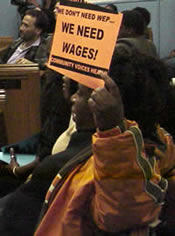 |
 |
Coming up with a concise and compelling message that motivates voters and feels comfortable for the field organizers who’ll be saying it a dozen or more times a day is hard enough. On top of that, you’ll want to translate the core message into a slogan or catch phrase – something that will be a part of the project’s literature and signs, like Community Voices Heard’s proclamation of “We don’t need WEP ... We need wages!” And when you factor in the anxiety that 501(c)(3) organizers feel about saying the wrong thing – well, it can be intimidating. We think it’s much more productive to focus on what you can say, but first, briefly, here’s what you can’t:
If you frame your message in terms of building power for the community, the restrictions shouldn’t be a problem. The following are the ingredients found, to greater and lesser degrees, in nonpartisan messaging:
 Issue Advocacy
Issue AdvocacyA clear distillation of the issues identified in the political context analysis stage. If you surveyed constituents and/or spent a bit of time educating membership on these issues, you’ll have a framework in place for the script. To get people’s attention, this part of the message has to be current and relevant – but not repeating what folks are hearing every day in the media. SouthWest Organizing Project organizers took this approach when they decided to include immigrants’ rights in their messaging for the primary election of June 2006, as Robby Rodriguez explains.
There are two basic strains of voter education: Disenfranchised communities have good reason to distrust the political system; the job of outreachers is to let their constituents know that they can demand accountability from elected officials and gain power by turning out the vote. Henry Serrano says that Community Voices Heard field organizers talk to voters about key issues and explain that having allies in government can make a difference.
As the low voter turnout rates in the States may indicate, many folks are anxious about voting itself (and, in many cases, with good reason – in the past two general elections there have been dozens of reports of polling stations in low-income neighborhoods where voters were harassed, denied the right to vote or forced to wait in long lines). The voter protection piece of the message should be designed to inform people the when, where and how of voting as well assure them of their rights and provide them with recourse should they encounter difficulties.
Field organizers provide context for the turnout project by giving a bit of background information on the organization. The advantages of including this brief narrative are first that it lets voters know that the person at their dooris a member of their community and not one of those election season “parachuters,” and second, that it increases awareness of your group’s ongoing advocacy work and marks the first step to building your base. The disadvantage is that it takes the attention off the purpose of the visit: turning out the vote. For this reason, when SCOPE field organizers are out door-knocking about ballot initiaves they generally stick to a script that’s exclusively about the upcoming election. Nevertheless, as Anthony Thigpenn has pointed out, by gauging their general interest in the issues, well-trained door-knockers can identify “leads,” folks who are likely to become SCOPE volunteers. A great way to inform folks about your organization without taking up too much time is to hand out flyers that voters can look over themselves.